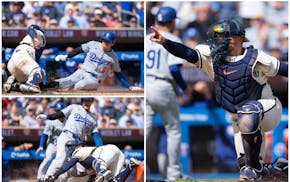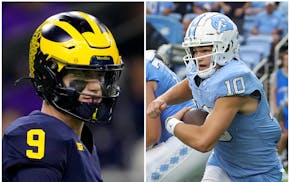Darroll Powe saw the Vancouver player load up to take a slapshot, and his instincts took over. Powe didn't have time to skate into the shooting lane so he chose a less desirable option.
Without hesitation, he dived onto the ice, trying to block the shot with his body.
Thud!
The puck ricocheted off Powe's foot, leaving him hobbled as he continued his shift on the penalty kill. That is the very definition of taking one for the team. A guy willing to throw his body in front of a hard puck traveling at a ridiculous speed, knowing there's a decent chance it will drill a body part not covered by pads.
"It's something you don't really think about whether it's going to hurt or not when you're doing it," said Powe, the Wild's penalty-killing specialist. "Most of them don't hurt. But you definitely get the odd one that hurts a lot. Those stick in your head. But it's what we're paid to do."
It takes a certain kind of crazy to act as a human bull's-eye, but hockey players do it all the time. They don't always go prone, but blocked shots are a vital, if unglamorous, part of the job.
Wild coach Mike Yeo calls it an "all-in" mindset, and his team is ranked first in the NHL in blocked shots with 318. The Wild averages 17 blocks per game. A dozen players already have reached double digits in blocks, a stat that suggests a collective willingness to share the pain.
Yeo went out of his way to credit Powe's shot-blocking after his team pummeled Vancouver 5-1 a few weeks ago. He didn't want Powe's dirty-work contribution to go unnoticed amid the offensive fireworks.
"It's real nice when your name shows up in the scoresheet at the end of the night," Yeo said. "But the reality is, there's so much more than that that goes into winning hockey games."
Wild players have welts and bruises to prove it. They take pride in blocking shots. A few even smiled when asked to recall their most painful ones.
Powe: "Last year against [Montreal's] Hal Gill. I still feel it today. It was right off the ankle bone. It hurt for a long time. It was just a full-on slapper. I think he was actually going for my ankle."
Defenseman Greg Zanon: "[Marek] Zidlicky's first year here and I was still in Nashville. He hit me with a one-timer right inside of the knee. That didn't allow me to walk for a couple of days."
In hockey, a good shift, check or penalty kill can ignite a team. A blocked shot at a key time can have the same effect.
Nobody knows that better than Zanon, a human bruise who has blocked 1,057 shots in his NHL career. He has finished in the top 10 in the league in blocked shots five consecutive seasons, a streak that likely will end because of a lingering groin injury.
Zanon learned the intricacies of blocking shots at Nebraska-Omaha. His coach would fire tennis balls at the players and they would work on body positioning and knowing where to absorb the shot. Zanon found his niche and quickly learned the importance of that skill.
"I was trying to find a way into the league," he said. "I was an offensive guy in college and had to become kind of a defensive specialist."
Players are so adept at blocking shots -- particularly on the penalty kill -- that they're able to minimize the physical toll. Even when the situation requires them to lay out, they often contort their body accordingly.
"You try and put your body so you're protecting your face a little bit," Powe said.
Many players, including Zanon, wear a lightweight piece of plastic over their skates to protect their feet from rocket shots. Some worry the protective cover will affect their skating, but Zanon understands the consequences of leaving his feet exposed.
"You take enough in the foot that it's tough in the morning to put your skate back on when your foot is bruised," he said.
That's just an occupational hazard as a shot-blocker. Most shots find their pads, some don't. The unknown is rarely a deterrent. See puck, stop puck by whatever means necessary.
"You don't even think," defenseman Justin Falk said. "It just becomes natural. If it hits you, you're happy. It hurts, but that's part of it. As soon as you find yourself being tentative in those shooting lanes, that's when you're going to miss it."
Chip Scoggins • ascoggins@startribune.com
Scoggins: 'Wait one more year' can't be the Wild's plan. Thankfully, it isn't.

Scoggins: Finch feeling heat of the Suns as playoff battle looms
Scoggins: Why 'championship or bust' fits these Wolves

Scoggins: Anatomy of a game-saving play as Correa throws out Ohtani

